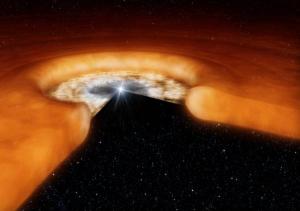Astronomers have used ESO's Very Large Telescope Interferometer to conduct the first high resolution survey that combines spectroscopy and interferometry on intermediate-mass infant stars. They obtained a very precise view of the processes acting in the discs that feed stars as they form. These mechanisms include material infalling onto the star as well as gas being ejected, probably as a wind from the disc.

© ESO/L. CalçadaArtist's impression of the environment of a young star, showing the geometry of the dust disc in the outer area and the hot gas disc closer to the central star. Note that the image is not to scale and the inner gas disc, which was studied by the astronomers using ESO's Very Large Telescope Interferometer, is smaller than the distance between the Earth and the Sun, while the whole disc is tens of times larger.
Infant stars form from a disc of gas and dust that surrounds the new star and, later, may also provide the material for a planetary system. Because the closest star-forming regions to us are about 500 light-years away, these discs appear very small on the sky, and their study requires special techniques to be able to probe the finer details.
This is best done with interferometry, a technique that combines the light of two or more telescopes so that the level of detail revealed corresponds to that which would be seen by a telescope with a diameter equal to the separation between the interferometer elements, typically 40 to 200 metres. ESO's Very Large Telescope Interferometer (VLTI) has allowed astronomers to reach a resolution of about a milli-arcsecond, an angle equivalent to the size of the full stop at the end of this sentence seen from a distance of about 50 kilometres.
